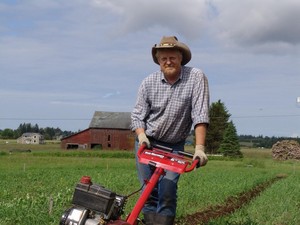11 Feb Wed 2009
Darwinist Agriculture
February 12th is the 200th birthday of Charles Darwin. Whether or not we acknowledge it, farmers are using Darwinist agriculture every day. We look at our plants or our animals and select for characteristics that arose out of mutations and recombination at both the genetic and chromosomal level. Although we are using artificial selection mostly (i.e. selecting positively - best milker, best tomato, etc.), we also cull, a process of natural selection (i.e. selecting negatively - eating the chicken that doesn't lay eggs or the potato that is scabby). In point of fact, the origins of agriculture are most likely the result of random mutation influenced by human agency. Plant biologists estimate 25-50% of all plant species are polyploid (more than 2 sets of complete chromosomes). Many of the plants we grow for food are polyploids - oats, potatoes, bananas, peanuts, barley, plums, apples, sugarcane, coffee and wheat - also cotton. So . . . the likely scenario for wheat was: 1) Wild wheat is diploid, with 2 sets of 7 chromosomes for a diploid number of 14. 2) Natural hybridization (i.e. in the wild) and chromosomal doubling produced a mutation of tetraploid wild emmer wheats, with 4 sets of 7 chromosomes for a diploid number of 28. 3) Now the early farmers had a wheat they could work with. 4) Further mutations and human agency produced our modern wheat which is a hexaploid of 6 sets of 7 for a diploid number of 42.
The genius of Darwin was his impeccable argument that "something" is causing changes and those changes are having an effect on who reproduces. He didn't know that the "something" was random mutation, but also did not get discouraged and devolve into spiritualism, like Alfred Wallace. It took Gregor Mendel to put together the genetic basis of darwinism and Ronald Aylmer Fisher to unite the two into neo-darwinism. By the way, Fisher developed analysis of variance as a way to try and make some sense of the agricultural data at the Rothamsted Experimental Station. Now we are comfortable with randomness, natural selection and a long timeline for these two processes to work. However, in 1859 evolution by natural selection was a revolutionary idea.

